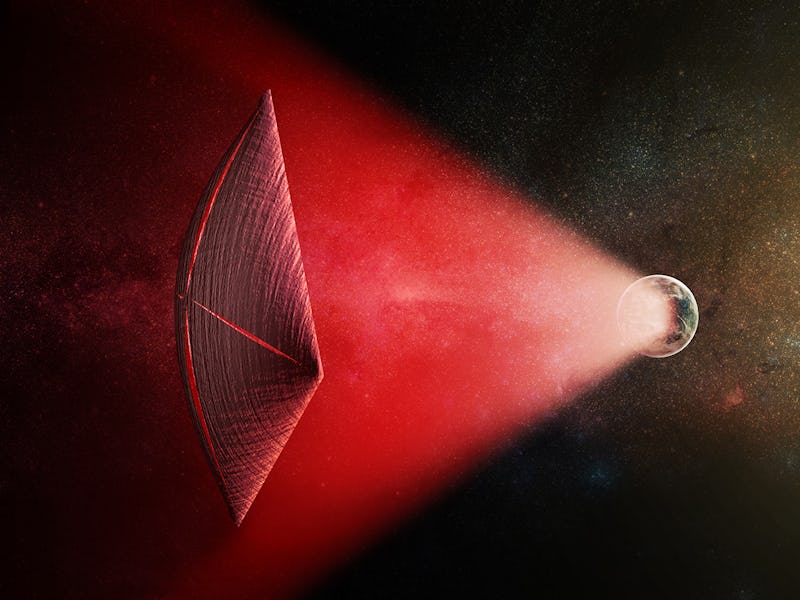The origin of fast radio bursts sweeping across outer space have puzzled scientists for years, but some scientists are examining the possibility that these millisecond-long radio emission flashes come from advanced alien technology in extragalactic civilizations. FRBs have traits that match up with artificial radio waves, and that might not be a coincidence.
In the paper published in The Astrophysical Journal Letters, Harvard researchers describe what a transmission device that emits FRBs may look like. Since 2007, fewer than two dozen FRB’s have been detected by large radio telescopes like the Arecibo Observatory in Puerto Rico.
Theorist Avi Loeb of the Harvard-Smithsonian Center for Astrophysics is working on the Breakthrough Starshot project, which would send a lightweight spacecraft powered by light. This inspired him to study whether an alien civilization may use similar technologies that transmit FRBs by launching a light sail at the speed of light.
“We are trying to push a very lightweight spacecraft that weighs a gram or so,” Loeb tells Inverse. “A much more advanced civilization might very well develop a technology that can launch much heavier payloads. It’s the same principle. You attach the payload to the sail and you push the sail with light.”
The FRB parameters were consistent with this idea, lending credence to the possibility that FRBs may be artificial in origin.
“Naturally, we were very surprised and excited to discover that an artificial origin for FRBs was compatible with the known data,” coauthor Manasvi Lingam of the Harvard-Smithsonian Center for Astrophysics tells Inverse.
Researchers speculate that FRBs might be leakage from planet-sized transmitters that power interstellar probes. This beamer must be of a size comparable to Earth, and the required power is the amount of sunlight a planet twice the size of Earth receives. This can generate enough power to push 20 large cruise ships.
From an engineering perspective, it’s possible for this device to withstand the heat with a water-cooled device twice the size of Earth. The speculated transmission device would need to focus a beam on a light sail continuously to power it.
“We found that the amount of power that you need is similar to the amount of sunlight intercepted by Earth,” Loeb says. “If you can imagine harvesting the starlight and using it for the purpose of propelling a light sail, it could work.”
Scientists suspect FRBs are artificial partly because of their brightness. The signals exhibit a brightness temperature of 10^37 degrees. To achieve such a high brightness at room temperature, electrons must move coherently, which is what happens in a radio antenna when an alternating electric field is applied to a wire.
No known object in space generates radio bursts at such high brightness. In addition, FRBs repeat in an irregular fashion and are concentrated around a particular radio frequency that’s different from natural sources in space. For example, pulsars operate based on coherent emission, but their emission is much weaker than FRBs.
“It cannot be associated with a cataclysmic event like the collapse of a star,” Loeb says. “Therefore it’s worth entertaining the possibility that it’s artificial.”
This research may lead to a more in-depth SETI-based study of the sources of FRBs through the Breakthrough Listen project. Right now there’s no good explanation for the origin of FRBs, but scientists can continue finding more clues. Previously, Loeb proposed a way for citizen scientists to detect FRBs using cell phones, which can give scientists clues for where they come from.
“We plan to look at other ways by which the signatures of advanced civilizations may be detectable by humans,” Lingam says. “Most of them are connected to how civilizations can tap energy sources for undertaking large-scale engineering projects.”
Although this hypothesis for the origin of FRBs is speculative, Loeb says he would have no problem accepting an alternative explanation if evidence shows otherwise.
“The exciting aspect of doing science is that one rules out possibilities with better data,” Loeb says. “The history of science shows that it would be unwise to rule out possibilities just based on prejudice. This often leads to stagnation rather than progress.”
Abstract: We examine the possibility that Fast Radio Bursts (FRBs) originate from the activity of extragalactic civilizations. Our analysis shows that beams used for powering large light sails could yield parameters that are consistent with FRBs. The characteristic diameter of the beam emitter is estimated through a combination of energetic and engineering constraints, and both approaches intriguingly yield a similar result which is on the scale of a large rocky planet. Moreover, the optimal frequency for powering the light sail is shown to be similar to the detected FRB frequencies. These `coincidences’ lend some credence to the possibility that FRBs might be artificial in origin. Other relevant quantities, such as the characteristic mass of the light sail, and the angular velocity of the beam, are also derived. By using the FRB occurrence rate, we infer upper bounds on the rate of FRBs from extragalactic civilizations in a typical galaxy. The possibility of detecting fainter signals is briefly discussed, and the wait time for an exceptionally bright FRB event in the Milky Way is estimated.
